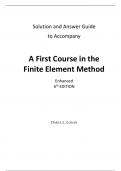Examen
Solutions for A First Course in the Finite Element Method, Enhanced 6th Edition Logan (All Chapters included)
- Cours
- Établissement
Complete Solutions Manual for A First Course in the Finite Element Method, Enhanced 6th Edition by Daryl L. Logan ; ISBN13: 9780357676424....(Full Chapters included Chapter 1 to 16)...1. INTRODUCTION. 2. INTRODUCTION TO THE STIFFNESS (DISPLACEMENT) METHOD. 3. DEVELOPMENT OF TRUSS EQUATIONS. 4. D...
[Montrer plus]



